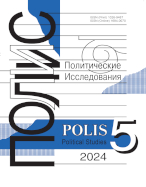Network Modeling of Mass Political Consciousness. A Method
Blagoveshchensky Yu.N.,
Leading Expert, INDEM Foundation, vkbun@yandex.ru
elibrary_id: 85428 |
Satarov G.A.,
President, INDEM Foundation, moskars@mail.ru
elibrary_id: 165292 |
DOI: 10.17976/jpps/2019.05.08
Blagoveshchensky Yu.N., Satarov G.A. Network Modeling of Mass Political Consciousness. A Method. – Polis. Political Studies. 2019. No. 5. https://doi.org/10.17976/jpps/2019.05.08
The article presents the experience of constructing three networks and a comparative analysis of these, where the nodes are the vectors of respondents' answers to almost identical sociological questionnaires in three countries – Russia, Kazakhstan, and Estonia. The questionnaires that regarded citizen’s political attitudes and the practices of these three countries have been used in polls conducted between the spring and the fall of 1998. The set of respondents' replies to one questionnaire was represented as a set of binary vectors. These binary vectors correspond to the nodes of the constructed network. At the initial stage, the standardized residuals, as measures of statistical dependence between nodes (response vectors), were used as measures of the connection between nodes. Thus, a weighted network of each survey was obtained. After that, according to the general formal rule of the threshold of determination, there has been a transition from a weighted to a binary network. The main subjects of comparative analysis were the topological (structural) properties of such binary networks which are used in network studies on networks from different origin. The networks constructed in this way were then used in the study as models of the respondents' mass consciousness. The authors studied and interpreted the cluster structure of networks that include the structure of a particular degree distribution of network nodes. This helped the authors to obtain significant results concerning the degree of distribution in the networks nodes examinded. The hypothesis that these networks shape a separate class of complex networks is confirmed. The study provides sociological facts that could not be found out by traditional methods of statistical analysis of poll results, based on counting the frequency of responses in the whole sample and within the standard groups. These results suggest that the proposed approach allows us to interpret the networks that are constructed by the proposed method as models of mass consciousness, and that this network approach allows new verifiable facts about mass consciousness to be obtained. The authors provide ideas of possible directions of scientific research in this field.
References
Newman E.J. 2003. The Structure and Function of Complex Networks. – SIAM Review. Vol. 45. No. 2. P. 167-256. https://doi.org/10.1137/S003614450342480
Rubinov M., Sporns M. 2010. Complex Network Measures of Brain Connectivity: Uses and Interpretations. – Neuro Image. Vol. 52. P. 1059-1069. https://doi.org/10.1016/j.neuroimage.2009.10.003
van Meter K.M. 2004. How People See Society The Network Structure of Public Opinion Concerning Social Conflicts. – CONNECTIONS. Vol. 26. No. 1. P. 71-89.
Adorno Th. 2001. Autoritare Personlichkeit. (Russ. ed.: Adorno Th. Issledovanie avtoritarnoi lichnosti. Moscow: Serebryanye niti).
Blagoveshchenskii Yu.N., Vinyukov I.A. 2004. Analiz vyborov v Dumu-2003 i stratifikatsiya izbiratelei [Analysis of the 2003 Duma Elections and Stratification of Voters]. – Internet-monitoring vyborov 2003-2004 godov v Rossii (Grazhdanskaya initsiativa proekta “Informatika dlya demokratii – 2000+”) [Internet Monitoring of the 2003-2004 Elections in Russia (Civil Initiative of the Project “Computer Science for Democracy – 2000+”)]. Vol. 2. P. 504-522. Moscow: INDEM Foundation. (In Russ.)
Latour B. 2004. Reassembling the Social. An Introduction to Actor-Network-Theory. (Russ. ed.: Latour B. Peresborka sotsial’nogo: vvedenie v aktorno-setevuyu teoriyu. Moscow: Higher School of Economics Publ.)
Luhmann N. 2005. Die Gesellschaft der Gesellschaft. (Russ. ed.: Luhmann N. Media kommunikatsii. Moscow: Logos).
Luhmann N. 2007. Soziale Systeme. Grundruss einer allgemeinen Theorie. (Russ. ed.: Luhmann N. Sotsial‘nye sistemy. Ocherk obshchei teorii. Saint Petersburg: Nauka).
Rossiiskaya korruptsiya: uroven‘, struktura, dinamika. Opyty sotsiologicheskogo analiza. 2013. Pod red. G.A. Satarova [Russian Corruption: Level, Structure, Dynamics. the Experiences of Sociological Analysis. Ed. by G.A. Saratov]. Moscow: Fond “Liberal’naya Missiya”. (In Russ.)
Samoregulyatsiya i prognozirovanie sotsial’nogo povedeniya lichnosti: Dispozitsionnaya kontseptsiya. 2013. [Self-Regulation and Prediction of Social Personality Behavior: A Dispositional Concept]. Moscow: TsSPiM. (In Russ.)
Satarov G.A. 2003. Sotsial’nyi intellekt i dinamika dispozitsii [Social Intelligence and Disposition Dynamics]. Moscow: INDEM Foundation. (In Russ.)
Satarov G.A. 2016a. Trust as an Object of Political Sociology. Part I. – Polis. Political Studies. No. 1. P. 121-138. (In Russ.) https://doi.org/10.17976/jpps/2016.01.09
Satarov G.A. 2016b. Trust as an Object of Political Sociology. Part II. – Polis. Political Studies. No. 2. P. 109-130. (In Russ.) https://doi.org/10.17976/jpps/2016.02.09
Satarov G.A. 2017. A New Approach to the Empirical Analysis of Mass Political Consciousness. – Political Science (RU). No. 1. P. 59-89. (In Russ.)
Shefer D., Kefer K. 1988. Struktury sluchainykh silikatov: polimery, kolloidy i poristye tverdye tela [Random Silicate Structures: Polymers, Colloids, and Porous Solids]. – Fraktaly v fizike: Trudy VI mezhdunarodnogo simpoziuma po fraktalam v fizike [Fractals in Physics: Proceedings of the VI International Symposium on Fractals in Physics]. Moscow: Mir Publ. P. 62-71. (In Russ.)
See also:
Satarov G.A., Blagoveshchensky Yu.N.,
Network modeling of mass political consciousness. First results. – Polis. Political Studies. 2022. No3
Satarov G.A.,
Trust as an Object of Political Sociology. Part II. – Polis. Political Studies. 2016. No2
Satarov G.A.,
Trust as an Object of Political Sociology. Part I. – Polis. Political Studies. 2016. No1
Latov Yu.V.,
Dynamics of mass consciousness of Russians: extraordinary situation or beginning of a new cycle?. – Polis. Political Studies. 2023. No6
Chugrov S.V.,
Mikhail Gorshkov’s experience of social diagnostics. – Polis. Political Studies. 2012. No6





.jpg)






 print
print
.jpg)
.jpg)